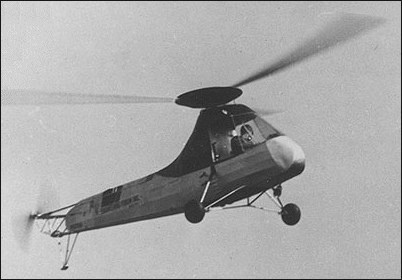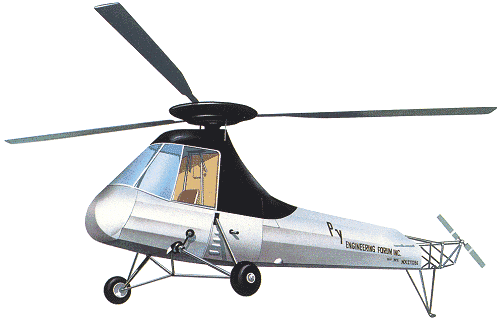
| Piasecki PV-2 1949 |  |
 |

| Piasecki PV-2 1949 |  |
 |
|
He is Frank N. Piasecki, President of the PV-Engineering Forum, an organization he formed with F.M.Vinsie and Elliott Daland for the purpose of building his helicopter. Records show he is the first American to be granted a license to fly a helicopter before first qualifying to fly a conventional airplane. He did, however, previous to flying his own helicopter design, get in some flying time in a light plane. This helped him, too, in building the PV. Piasecki's helicopter has a gross load of half a ton, which includes pilot and fuel load, as well as the craft itself. The rotor disk is 7.6m in diameter. There are three blades. Two blades fold back like the wings on a fly to permit storage. Altogether it is only 6.7m long (when blades are folded back), about 2.3m high, and 2.4m wide. There is room for one person (pilot), who sits in a conventional seat behind a rounded, glassed-in nose, similar to the front end of an early Aeronca light plane. The fuselage is fabric-covered. Control of the PV-model is actuated like that of the XR-4. It has cyclic pitch control of its rotor blades. There is the conventional rudder-stick combination, rudder action manipulating a five-foot tail rotor similar to the vertical rotor on the XR-4. The PV-2 helicopter is powered with a four-cylinder, air-cooled Franklin engine, developing ninety horsepower. The engine is mounted with its crankshaft upright. Piasecki has flown his helicopter in several public demonstrations. Once he took off from the driveway of a private home in Falls Church, Virginia, and flew a short distance to a filling station, where he landed and spent an A ration stamp for three gallons of gasoline. The surprised attendant put in the gas, wiped off the helicopter's windshield, and Piasecki took off again, heading for the golf course. A few minutes later he landed right beside the first tee, took his golf clubs out of the small baggage compartment, and proceeded to tee off for a game of golf. The young designer had done what many had talked about; no one had ever done that before. H.F.Gregory "Anything a Horse Can Do. The story of the Helicopter", 1944  Towards the end of 1943, Frank Nicholas Piasecki also appeared on the scene. He had previously been involved in development of the Platt-LePage XR-1 and had undertaken a small-scale project of his own. The PV-2 weighed just under 500kg and was powered by a 90hp Franklin. It had a three-blade articulated rotor with folding blades. He flew the aircraft several times in public, creating a sensation, but it was then dropped because Piasecki turned his attention to the more ambitious field of large military helicopters; with the PV-3 he returned to the twin-rotor formula which had given rise to his earlier experiment. G.Apostolo "The Illustrated Encyclopedia of Helicopters", 1984 Frank N. Piasecki was the holder of the first US helicopter pilot's licence and he formed the P V Engineering Forum in 1943 to develop practical rotorcraft. His first successdul design was the experimental Piasecki PV-2 single-seater with a 67kW Franklin flat-four engine driving a three-blade main rotor. Piasecki himself was the pilot for the first flight, made on 11 April 1943. D.Donald "The Complete Encyclopedia of World Aircraft", 1997 * * * R.Simpson "Airlife's Helicopter and Rotorcraft", 1998 * * *
|